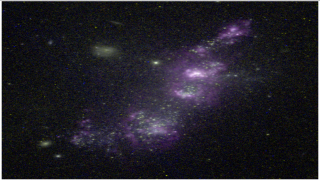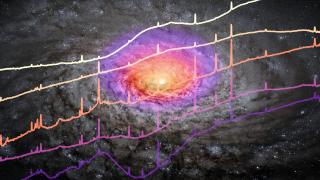Bibcode
Lopez-Rodriguez, E.; Packham, C.; Tadhunter, C.; Mason, R.; Perlman, E.; Alonso-Herrero, A.; Ramos Almeida, C.; Ichikawa, K.; Levenson, N. A.; Rodríguez-Espinosa, J. M.; Álvarez, C. A.; Ramírez, E. A.; Telesco, C. M.
Referencia bibliográfica
The Astrophysical Journal, Volume 793, Issue 2, article id. 81, 7 pp. (2014).
Fecha de publicación:
10
2014
Revista
Número de citas
14
Número de citas referidas
14
Descripción
We present high-angular (~0.''4) resolution mid-infrared (MIR)
polarimetric observations in the 8.7 μm and 11.6 μm filters of
Cygnus A using CanariCam on the 10.4 m Gran Telescopio CANARIAS. A
highly polarized nucleus is observed with a degree of polarization of
11% ± 3% and 12% ± 3% and a position angle of polarization
of 27° ± 8° and 35° ± 8° in a 0.''38 (~380
pc) aperture for each filter. The observed rising of the polarized flux
density with increasing wavelength is consistent with synchrotron
radiation from the parsec-scale jet close to the core of Cygnus A. Based
on our polarization model, the synchrotron emission from the
parsec-scale jet is estimated to be 14% and 17% of the total flux
density in the 8.7 μm and 11.6 μm filters, respectively. A
blackbody component with a characteristic temperature of 220 K accounts
for >75% of the observed MIR total flux density. The blackbody
emission arises from a combination of (1) dust emission in the torus;
and (2) diffuse dust emission around the nuclear region, but the
contributions of the two components cannot be well-constrained in these
observations.
Proyectos relacionados

Grupo de Estudios de Formación Estelar GEFE
El proyecto interno GEFE está enmarcado en el proyecto coordinado, ESTALLIDOS, financiado por el plan nacional desde el año 2001. El ultimo proyecto aprobado es ESTALLIDOS 6.0 (AYA2016- 79724-C4-2-P). En el proyecto GEFE trabajamos en base al caso científico del proyecto ESTALLIDOS 6.0. Los estallidos de formación estelar (Starbursts o SB) son
Casiana
Muñoz Tuñón

Actividad Nuclear en Galaxias: una Perspectiva 3D del Núcleo y su Entorno
Nuestro proyecto puede dividirse en dos líneas principales de investigación. En primer lugar, el estudio de los vientos producidos por cuásares luminosos oscurecidos y del impacto que estos tienen en sus galaxias anfitrionas (retroalimentación del AGN). Para ello hemos obtenido observaciones en el óptico e infrarrojo cercano con el Gran Telescopio
Cristina
Ramos Almeida